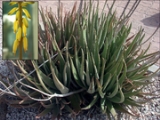
Aloe vera
Overview
Aloe vera, pronounced ˈ, also known as the true aloe or medicinal aloe, is a species of succulent plant
in the genus Aloe
that is believed to have originated in the Sudan
. Aloe vera grows in arid climates and is widely distributed in Africa, India, Nepal and other arid areas.
The species is frequently cited as being used in herbal medicine. Many scientific studies on the use of extracts of Aloe vera have been undertaken, some of them conflicting.
Despite these limitations, there is some preliminary evidence that Aloe vera extracts may be useful in the treatment of wound and burn healing, minor skin infections, sebaceous cyst
s, diabetes, and elevated blood lipids
in humans.
Succulent plant
Succulent plants, also known as succulents or fat plants, are water-retaining plants adapted to arid climates or soil conditions. Succulent plants store water in their leaves, stems, and also in roots...
in the genus Aloe
Aloe
Aloe , also Aloë, is a genus containing about 500 species of flowering succulent plants. The most common and well known of these is Aloe vera, or "true aloe"....
that is believed to have originated in the Sudan
Sudan
Sudan , officially the Republic of the Sudan , is a country in North Africa, sometimes considered part of the Middle East politically. It is bordered by Egypt to the north, the Red Sea to the northeast, Eritrea and Ethiopia to the east, South Sudan to the south, the Central African Republic to the...
. Aloe vera grows in arid climates and is widely distributed in Africa, India, Nepal and other arid areas.
The species is frequently cited as being used in herbal medicine. Many scientific studies on the use of extracts of Aloe vera have been undertaken, some of them conflicting.
Despite these limitations, there is some preliminary evidence that Aloe vera extracts may be useful in the treatment of wound and burn healing, minor skin infections, sebaceous cyst
Sebaceous cyst
A sebaceous cyst is a term that loosely refers to either epidermoid cysts or pilar cysts . Because an epidermoid cyst originates in the epidermis and a pilar cyst originates from hair follicles, by definition, neither type of cyst is strictly a sebaceous cyst...
s, diabetes, and elevated blood lipids
Blood lipids
Blood lipids are lipids in the blood, either free or bound to other molecules. They are mostly transported in a protein capsule, and the density of the lipids and type of protein determines the fate of the particle and its influence on metabolism. The concentration of blood lipids depends on...
in humans.
Discussions

